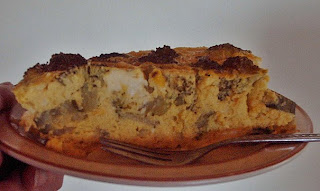It is a long time since Roy did both house-sitting and some building up at our plot.
At the housesit, he looked after three huge dogs, a cow and some calves as well as two horses. On the day he arrived there, the one horse had managed to get some baling wire wrapped around its foot and it must have been like that for a while because the foot was swollen and the horse could not stand on it. Luckily it was the old, tame horse and not the younger, totally wild one. Roy managed to clip the wire off and fortunately, a single application of some "green stuff" from a spray can was enough to ward off infection. By the time he left two weeks later, all was well.
 |
| House-sit | |
For the building work at our place, he managed once again to acquire the services of a retired bricklayer from Suurbraak. Peter can only work a maximum of three days a week because he finds that his old back cannot take more than that. He was an absolute star and between his back and the few sunny days interspersed between miserable rainy days, they managed four days of solid work.
Peter built the walls and John filled them in with soil.
We will move the one water tank from the verandah onto this extension.The other half will be used as a raised flower bed.
Peter cemented bricks into the holes that were still open from the original build. This should see the end of the field mice incursions into the building
He built the shower floor and was delighted that we wanted stones cemented into the floor. He collected them himself and enjoyed his creative input to the project.
The floor of the little bedroom and bathroom were given a final coloured screed on top of the rough concrete surface. It will be a long while before we can do the same in the main room.
The sand for this screed was sifted twice. Peter explained that if there are grass seeds in the sand, they would germinate and pop up out of the screed, creating a disturbed surface. You live and learn. Once the screed had dried, John gave the walls a final coat of paint.
John started the marathon project of cleaning the cement off the bricks inside the main room. It is a pity that we have had to spend so much time and money cleaning up the bricks, inside and outside. We did impress on the bricklayers at the time that we were going to leave the walls unplastered and unpainted but it seems that they were unable to build in a way that would leave the bricks clean.
All in all, I was thrilled with what Roy and his team managed to accomplish in such a short space of time.























.JPG)



























